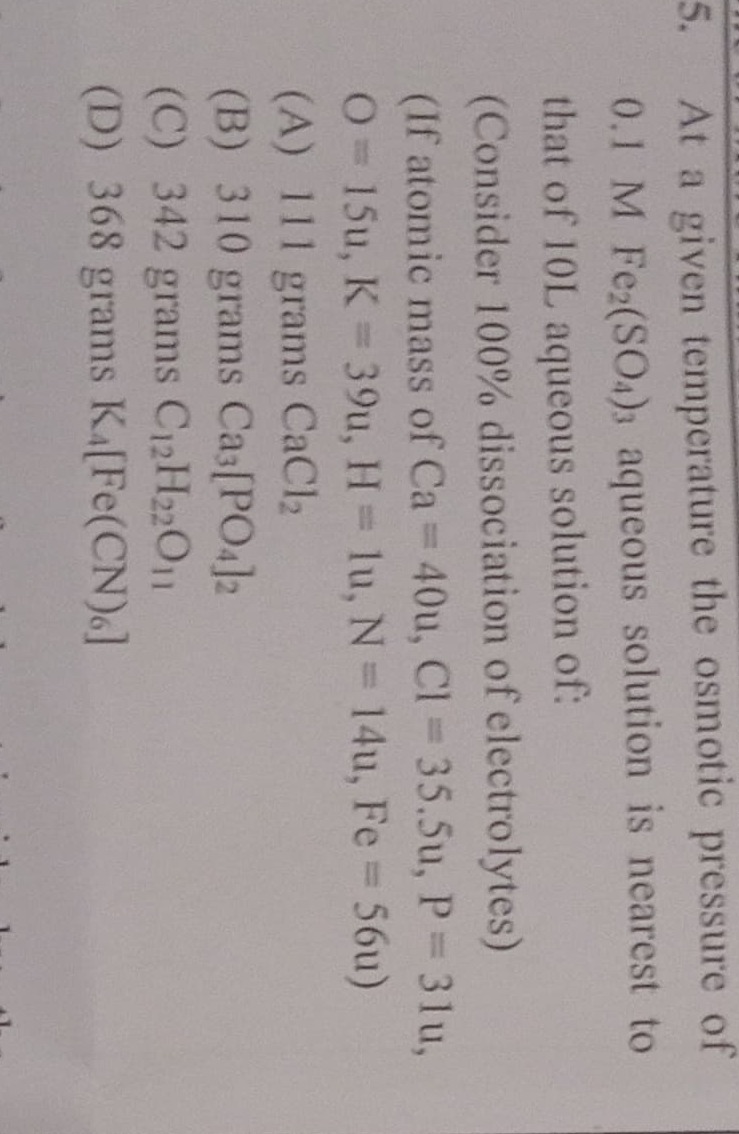Question
Question: At a given temperature the osmotic pressure of 0.1 M $Fe_2(SO_4)_3$ aqueous solution is nearest to t...
At a given temperature the osmotic pressure of 0.1 M Fe2(SO4)3 aqueous solution is nearest to that of 10L aqueous solution of: (Consider 100% dissociation of electrolytes) (If atomic mass of Ca = 40u, Cl = 35.5u, P = 31u, O = 15u, K = 39u, H = lu, N = 14u, Fe = 56u)

111 grams CaCl2
310 grams Ca3[PO4]2
342 grams C12H22O11
368 grams K4[Fe(CN)6]
D
Solution
The osmotic pressure (Π) of a solution is given by the formula: Π=iCRT
where:
- i is the van't Hoff factor (number of particles produced per formula unit of solute).
- C is the molar concentration of the solute.
- R is the ideal gas constant.
- T is the temperature in Kelvin.
Since the temperature (T) and the gas constant (R) are the same for all solutions, the osmotic pressure will be proportional to the product iC. We need to find the option whose iC value is closest to that of the given Fe2(SO4)3 solution.
1. Calculate iC for the reference solution: 0.1 M Fe2(SO4)3
Fe2(SO4)3 dissociates as: Fe2(SO4)3→2Fe3++3SO42−
Since 100% dissociation is assumed, the van't Hoff factor i=2+3=5.
The concentration C=0.1 M.
So, for Fe2(SO4)3, iC=5×0.1=0.5.
2. Calculate iC for each option:
Option (A): 111 grams CaCl2 in 10L aqueous solution
- Molar mass of CaCl2: 40 (Ca)+2×35.5 (Cl)=40+71=111 g/mol.
- Moles of CaCl2: 111 g/mol111 g=1 mol.
- Concentration (C): 10 L1 mol=0.1 M.
- Dissociation: CaCl2→Ca2++2Cl−
- Van't Hoff factor (i): 1+2=3.
- iC value: 3×0.1=0.3.
- Difference from target: ∣0.5−0.3∣=0.2.
Option (B): 310 grams Ca3[PO4]2 in 10L aqueous solution
- Molar mass of Ca3[PO4]2: 3×40 (Ca)+2×(31 (P)+4×15 (O))=120+2×(31+60)=120+2×91=120+182=302 g/mol.
- Moles of Ca3[PO4]2: 302 g/mol310 g≈1.0265 mol.
- Concentration (C): 10 L1.0265 mol=0.10265 M.
- Dissociation: Ca3[PO4]2→3Ca2++2PO43−
- Van't Hoff factor (i): 3+2=5.
- iC value: 5×0.10265=0.51325.
- Difference from target: ∣0.5−0.51325∣=0.01325.
Option (C): 342 grams C12H22O11 in 10L aqueous solution
- Molar mass of C12H22O11: 12×12 (C)+22×1 (H)+11×15 (O)=144+22+165=331 g/mol.
- Moles of C12H22O11: 331 g/mol342 g≈1.0332 mol.
- Concentration (C): 10 L1.0332 mol=0.10332 M.
- Dissociation: Sucrose is a non-electrolyte, so it does not dissociate.
- Van't Hoff factor (i): 1.
- iC value: 1×0.10332=0.10332.
- Difference from target: ∣0.5−0.10332∣=0.39668.
Option (D): 368 grams K4[Fe(CN)6] in 10L aqueous solution
- Molar mass of K4[Fe(CN)6]: 4×39 (K)+56 (Fe)+6×12 (C)+6×14 (N)=156+56+72+84=368 g/mol.
- Moles of K4[Fe(CN)6]: 368 g/mol368 g=1 mol.
- Concentration (C): 10 L1 mol=0.1 M.
- Dissociation: K4[Fe(CN)6]→4K++[Fe(CN)6]4−
- Van't Hoff factor (i): 4+1=5.
- iC value: 5×0.1=0.5.
- Difference from target: ∣0.5−0.5∣=0.
3. Comparison of iC values:
- Reference Fe2(SO4)3: iC=0.5
- Option (A) CaCl2: iC=0.3 (Difference = 0.2)
- Option (B) Ca3[PO4]2: iC=0.51325 (Difference = 0.01325)
- Option (C) C12H22O11: iC=0.10332 (Difference = 0.39668)
- Option (D) K4[Fe(CN)6]: iC=0.5 (Difference = 0)
Option (D) has an iC value exactly equal to the reference solution, meaning its osmotic pressure is identical. Therefore, it is the nearest.
